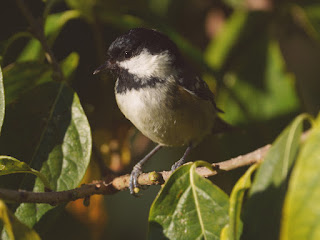The confident Coal Tit in the Flower Walk followed me along the path taking pine nuts from my hand.
A Jay was waiting to fly down and grab a peanut from my fingers.
A Long-Tailed Tit perched in an American oak near the leaf yard.
The Mistle Thrush in the rowan tree on Buck Hill was looking militant ...
... because it had just chased this Jay on to an upper branch.
There was also a Magpie in the tree, which the thrush hadn't dealt with. But these fierce birds do attack Magpies in the nesting season, so it was quite up to the contest.
Another Magpie rummaged in autumn leaves looking for insects and worms.
A visit to the Rose Garden found nothing more exotic than the local Robin ...
... and a Great Tit.
The Rose-Ringed Parakeets, so well hidden in the leaves in summer, are now glaringly exposed. They are predated by Tawny Owls, Sparrowhawks and Peregrines, and once Paul saw a Hobby eating one -- you would have thought Hobbies are too small to take them on.
A fine seasonal picture by Neil of leaves being cleared by a tractor-mounted blower.
This year the Kensington Gardens staff are trying a new technique. On the open lawns the leaves are not being collected, but are being chopped up by running the two mowing machines over them and left to lie, where they will rot and fertilise the grass. It saves a lot of labour in taking leaves to the leaf yard, composting them, and bringing the resulting leafmould back. They are also, to my great relief, not blowing leaves out of the shrubberies and so depriving Blackbirds and other thrushes of their foraging grounds. (This is mainly because, for 'green' reasons, they have been deprived of their petrol-driven blowers and issued with electric ones that couldn't blow the skin off a rice pudding.) But it can't be a complete solution, as leaves build up thickly in some places and still have to be collected.
A Grey Wagtail looked for insects in fallen leaves frozen into a thin layer of ice on the Serpentine.
A Carrion Crow washed on the dead willow near the Italian Garden ...
... climbed higher up the branch ...
... and shook itself dry.
The pigeon-eating Lesser Black-Backed Gull was in his usual place at the Dell restaurant preening his immaculate plumage. This picture clearly shows the remarkably deep yellow colour of his bill and feet, which I think is due to his rich diet. The colour comes from astaxanthin, a carotenoid pigment found in meat and fat. (It's also responsible for the yellow feathers of the Great Tit above; the bird gets it from insects.)
A Cormorant jumped on to a chain at the island and struggled for balance.














It makes sense that the rich yellow in the plumage of Pigeon Killer and Great Tits should be due to their protein-rich diet. What about Blue Tits, I wonder? They are less yellow but bright enough.
ReplyDeleteI remember when I tried to turn my pale yellow canary a deeper and brighter colour. I fed it cartenid-rich food till he begged for mercy. Everything I ever accomplished to show for it was to make him a lifelong enemy of carrots.
I'm sure the yellow front of Blue Tits, and for that matter yellow colours in other birds, are due to astaxanthin. It's also present in mammals including humans and is the reason fat is yellowish.
DeleteYou should have given your canary pistachios, pecans or sesame seed, which are all high in carotenoid pigments. I think the various pigments are converted to the necessary form when digested.
Those French yellow-fleshed chickens, _poulets de Bresse_, are fed maize.